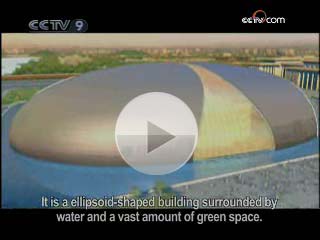Source: CCTV.com
12-15-2008 14:01
 |
People would enter the building via an underwater entranceway. The Great Hall of the People would be to its east and the Forbidden City to its northeast, but the architectural style of the National Center for the Performing Arts would be totally different from either of them.
Both international and Chinese media began to pay attention to Andreu’s daring design. From the beginning, the French newspaper Le Figaro compared the design to a beautiful pearl and stated it was one of the greatest architectural designs of the past century.
-da.jpg) |
However, the Argentinian newspaper Clarin said that Andreu’s dome would not sit in harmony with the surrounding building complex and it would become a scar on the city of Beijing. While everybody was trying to voice their opinions, the Owners Committee of the National Center for the Performing Arts made their final decision.
On July 22nd 1999, after a period of competition that had lasted a year and four months, the result of the bidding on the National Center for the Performing Arts was announced: the circular design from Paul Andreu with the assistance of Tsinghua University was the winner.
But at the same time, the Owners Committee also stated that as the location of the project was extremely special, the height was not exceed that of the Great Hall of the People next door.
That meant that one third of the National Center of the Performing Arts would have to be constructed underground. To meet the criteria and solve a difficult problem, Andreu decided the foundations would extend to a depth of 32.5 meters.
So what exactly did the engineers do when building the foundations of the National Center for the Performing Arts? First of all, they surrounded the foundations with huge cement silos to separate the groundwater under the building and then extracted the water from the cement silos.
In this way, they not only solved the problem of the foundations of the building, but also prevented the extraction of the groundwater from damaging the surrounding buildings. Finally they cast cement in the bottom of the cement silos.
By the end of 2002, construction of the foundations of the National Center for the Performing Arts was completed. The main structure was completed just a few months later in April of 2003.
What Paul Andreu needed to do next was focus on the interior design of the National Center for the Performing Arts. But Andreu had no experience in designing a national theatre. How would he meet such a huge challenge?
Editor:Yang Jie
